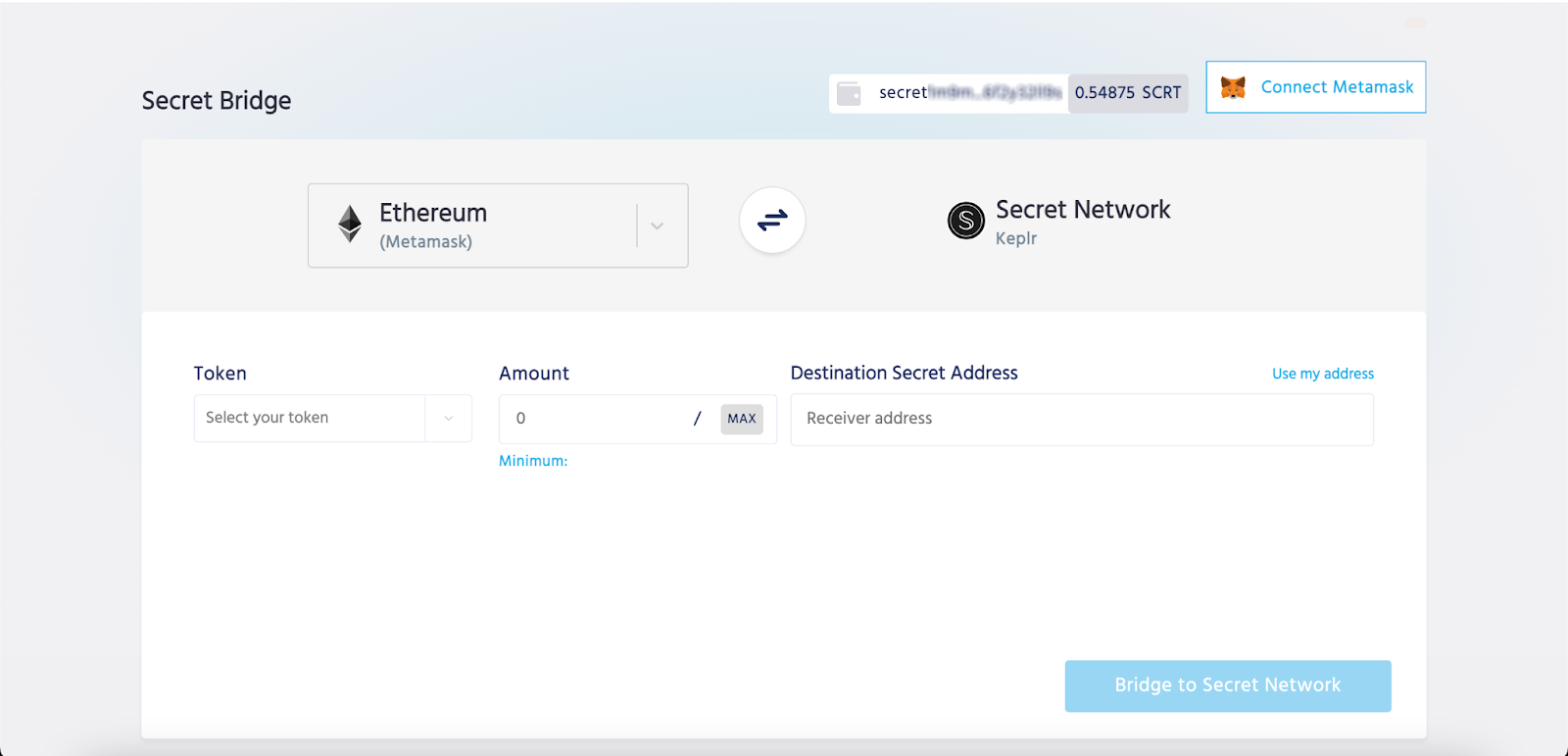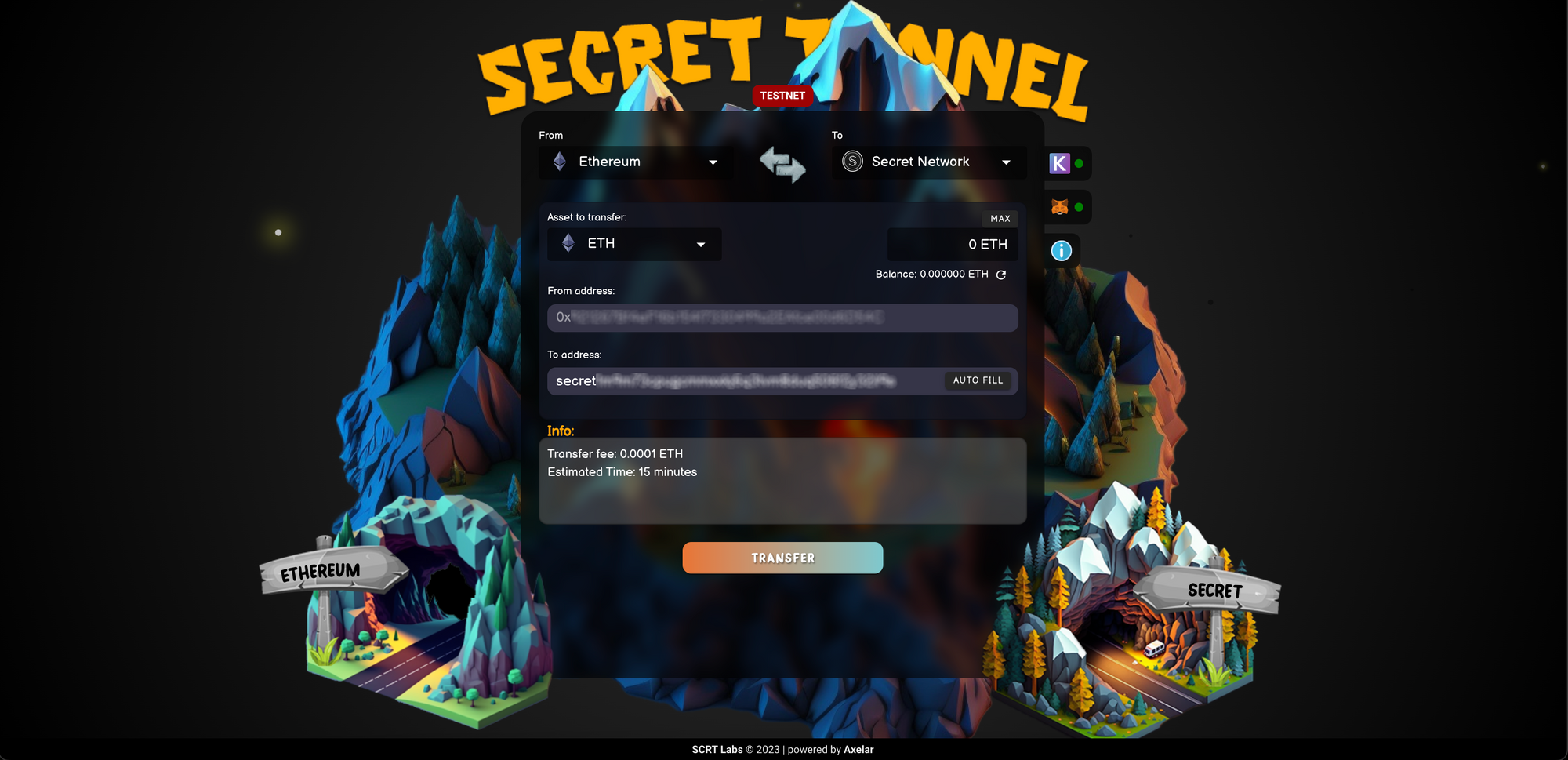Hello Secret Community!
We’re excited to announce that Secret Tunnel is now live on mainnet!
This new network bridge, powered by Axelar, replaces our old Ethereum and Binance Smart Chain bridges. With this upgrade comes increased decentralization and security for bridged assets, an improved user experience, and new Secret Tokens that include their own set of new features!
IMPORTANT: If you currently have Ethereum or Binance Smart Chain assets bridged onto the network, you will need to manually migrate these assets to the new Secret Tunnel bridge within the next 6 months.
Read on to learn more!
History of Secret Network Bridges
Interoperability has been a high priority for Secret since the early days of the network. This is one of the reasons that we chose to build on the Cosmos SDK, as it natively enabled connections to other networks via the IBC protocol. In addition to this, we also wanted to connect to EVM networks such as Ethereum and Binance Smart Chain. By doing so, people with assets on those networks would be able to bridge them over to Secret Network and gain privacy.
In 2020, the IBC ecosystem was still in its infancy, and a universal bridging solution for EVM to IBC did not yet exist. To make the connection, we needed to build our own custom bridges, and so we did just that. In December 2020, we launched the Secret Ethereum Bridge, and in June 2021, we launched the Secret Binance Smart Chain Bridge.

These bridges use a custodial and permissioned multisig model, relying on a few trusted parties to maintain nodes for the bridge infrastructure and secure the funds that they hold. This was standard practice for bridges a couple of years ago, but the issue with this design is that there are only a few points of failure. For example, if more than one of these nodes goes offline at the same time, it can result in the entire bridge being temporarily unusable, including the funds locked into it. Even worse, if multiple private keys involved in the multisig are somehow compromised by an attacker, all of the funds locked into the bridge can be drained. There have been multiple major hacks like this over the past two years.
Since that time, much improved bridge models have been developed, such as dedicated DPOS (delegated proof-of-stake) networks that serve the function of a bridge. One such network is Axelar. The Axelar bridge is a decentralized protocol that allows the transfer of assets between different blockchain networks. It functions by using a large network of relayers that facilitate the transfer of assets, as opposed to just a few relayers in a multisig model. Additionally, Axelar uses a trustless model, which means that users do not need to trust any intermediary to execute transactions. Trustless bridges make use of smart contracts and cryptographic techniques to ensure that assets are transferred securely.
Enter Secret Tunnel

Today, we’re launching Secret Tunnel, powered by Axelar. This new bridge will replace our old Ethereum and Binance Smart Chain bridges, and brings with it many improvements!
Decentralization
The infrastructure that Secret Tunnel runs on is far more decentralized and robust than our old Ethereum and Binance Smart Chain bridges, which are operated by just a few nodes. If a couple of nodes go offline, our old bridges become unusable. Secret Tunnel is operated by a very large network of nodes – the Axelar network. This means that as long as Axelar network is running, Secret Tunnel will be online!
Security
Our old bridges use a custodial multi-sig model to secure the funds locked into the bridge. There are five nodes, each of which possess a private key which is involved in the multi-sig, and at least three of them are required to execute all bridge transactions. If three of these private keys are compromised by attackers, bridge funds could be stolen.
Secret Tunnel makes use of Axelar’s permissionless delegated proof-of-stake network to secure funds and execute transactions. This means that users do not have to trust a few select parties with the keys to their bridged funds. Instead, Axelar makes use of smart contracts to provide a trustless bridge model, which means that compromising the keys required to execute transactions is far more difficult compared to a multi-sig model.
UI/UX
Secret Tunnel also brings with it a greatly improved user interface and user experience. The layout is intuitive and easy to use, connecting wallets is a breeze, and there’s even animated elements and notification sounds that make the bridging experience more fun!
New Secret Tokens
On Secret Network, SCRT is the native token used for staking, governance, and transaction fees. In addition to SCRT, there are many other tokens called Secret Tokens, or SNIP-20s. For those more familiar with Ethereum, the relationship is similar to that of ETH and ERC-20 tokens. SNIP-20s are privacy-preserving tokens based on Cosmos’ CW-20 specification. A common use case for SNIP-20s is representing tokens from other networks after they’ve been bridged to Secret. For example, when bridging ETH to Secret using the Secret Ethereum Bridge, it becomes sETH. sETH is a SNIP-20 that provides private balances and private transfers.
On a technical level, a SNIP-20 token is a smart contract that runs on Secret. The original SNIP-20 specification was published in 2020, and since that time several supplemental updates have been published, each of which have added new functionality for these smart contracts. This means that some SNIP-20s have additional features available, depending on when the token contract was launched. The latest update to the specification is known as SNIP-25, and new token contracts have just been launched which make use of this!
Transaction Timestamps
The original SNIP-20 token specification did not include a mechanism for reporting the time that a transaction took place. This is included in SNIP-25. Timestamps allow you to more easily keep track of your transaction history, and makes tax reporting much easier!
Improved Privacy
In a recent blog post we covered some vulnerabilities that had been discovered relating to the privacy features of SNIP-20 tokens. With SNIP-25, a new decoy mechanism has been added to help resolve these issues. This mechanism obfuscates the memory access patterns of token contracts.
Query Permits
Older versions of Secret Token contracts made use of an authentication method known as “viewing keys” to protect encrypted balances. A user would create a viewing key by sending a transaction which specified a password, which the contract would store. Later when a user wanted to see their token balance, they’d send a query which included the password, which the contract would check against the stored password. This was not an ideal user experience as it required users to send a transaction and pay a fee in order to view their balances. Also, if the network was highly congested, these transactions might not go through very quickly, resulting in users unable to view their balances.
Query permits are an alternative way of authenticating the user. Instead of storing a password in the contract’s state, a user signs a piece of data with their private keys, and then sends this data and the signature to the contract along with the query. The contract then validates the signature against the data, and returns an answer if the signature is validated. This way users don’t have to send a transaction before they can access their data.
Migrating Assets
Over the next six months, users should move any bridged assets currently locked into our old Ethereum and Binance Smart Chain bridges over to the new Secret Tunnel bridge. To migrate assets, users need to bridge them back to their native chains using the old bridge interface. Then, users can go to the new bridge interface and bridge the assets back to Secret. When doing so, tokens will automatically be upgraded to the new SNIP-25 token contracts mentioned above.
After the six month period is over, the old bridges will be shut down, and any assets that are still locked into them at that time will be manually migrated over to the new bridge. At that point, an interface will be made available which allows users to claim their native assets by providing the old wrapped Secret tokens.
Secret Surge

In addition to all of the new improvements that Secret Tunnel brings to the table, users should soon have even more reason to try out the new bridge. The Secret Surge on-chain funding proposal is currently in the voting period, and is expected to pass. This would bring incentivized rewards for providing liquidity on Secret DeFi dApps like Blizzard, SecretSwap, Shade, and Sienna. Users that bridge over funds and deposit them in these dApps may be eligible for rewards in SCRT as well as additional dApp tokens. The voting period ends on April 18th, and if it passes, rewards will go live the same day. Stay tuned!
Onwards and Upwards
To discuss Secret Network and Secret Apps, visit our community channels:

